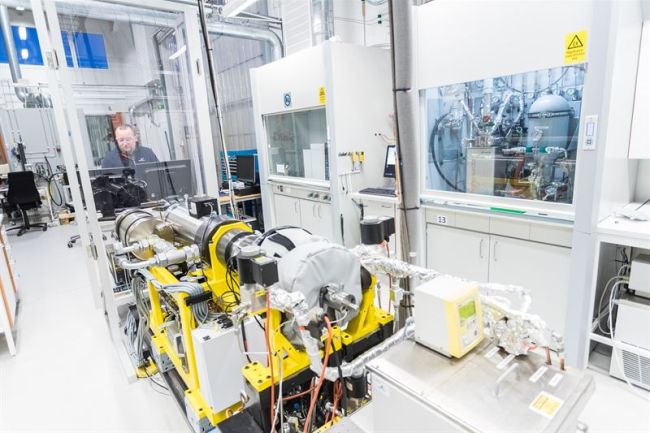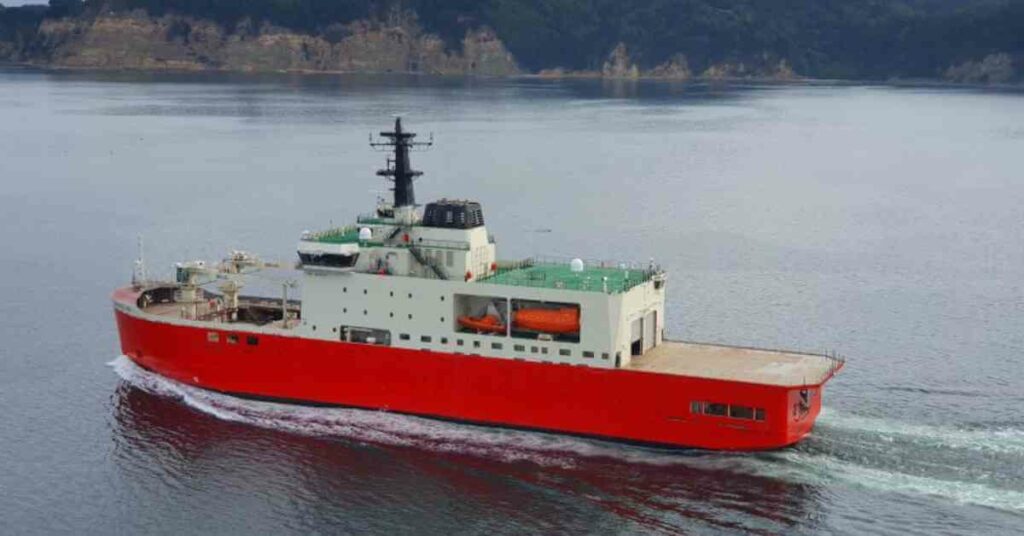What Does An Ammonia-Ready Vessel Look Like?
As carbon-neutral fuel choices narrow, shipowners are beginning to look more closely at how existing and newbuild vessels might use clean fuels. Ammonia is near the top of the list for many shipowners.
Ammonia has traditionally been produced from hydrocarbons, although in the future there is potential for carbon capture to reduce the emission footprint of production (so called ‘blue ammonia’) or for production from renewable, non-carbon sources such as wind or solar energy (‘green ammonia’).
Independent of how it is produced, ammonia certainly has the energy potential for a marine fuel, with an energy density of around 3kWh per litre (somewhere between hydrogen and LNG in terms of storage volume). But challenges including toxicity, corrosiveness, slow ignition, and NOx emissions will require a combination of new engine and fuel gas supply system technologies. The volume and weight of storage required also have a significant impact on the operating range of vessels.

These challenges are being investigated. Handling requirements, such as the requirement for stainless steel tanks to handle ammonia’s corrosive properties, are relatively well established from decades of transporting ammonia in LPG carriers. A fuel cell project underway with offshore shipowner Eidesvik is further exploring how ammonia needs to be handled as a fuel rather than as a cargo. On the engine side, Wärtsilä Marine Power performed combustion tests using ammonia in March, and plans to begin its first full-scale, four-stroke engine tests next year in collaboration with shipowner Knutsen OAS, energy company Repsol and the Norwegian Sustainable Energy Catapult Centre.
Starting to use ammonia
Like many of the emerging clean fuels, scaling up production to commercial quantities of blue or green ammonia may take many years. It is therefore unlikely that carbon-neutral ammonia will be available initially in big enough quantities to ensure that vessels will be able to run fully on carbon-neutral ammonia. At the same time, shipowners would be uncomfortable about switching to a new fuel overnight. The most likely scenario for using ammonia is therefore that owners will use it initially as a drop-in fuel, building up confidence in using and handling the fuel before eventually increasing their use and switching over to full reliance on ammonia.
According to Kaj Portin, General Manager, Fuel & Operational Flexibility, Wärtsilä Marine Power, engine development will follow this anticipated trend, moving from a diesel engine with ammonia capabilities to an engine that is more optimised for ammonia.

“The starting point is to use a small amount of ammonia while keeping the same performance as diesel,” he says. “As we increase the ratio of ammonia, we will look to optimise towards that fuel rather than diesel or gas.”
Combustion tests have already shown that ammonia can be used as a drop-in fuel with diesel. But this is in a laboratory setting. For real-world engines, ammonia requires extra safety precautions and new materials. Nickle and copper found in seals, gaskets, valves and electrical components would corrode quickly once exposed to ammonia, for example, as would most elastomers used in today’s engineering.
From an engine perspective, then, a shipowner interested in using ammonia would need a diesel or dual-fuel engine that was built using materials that can handle the corrosive nature of ammonia. Materials aside, an engine very similar to today’s diesel or dual fuel engines – ammonia can be used in both – could use small quantities of ammonia as a drop-in fuel, while later engines will be optimised for use of ammonia as a main fuel. Wärtsilä is in the process of defining the engine components and modules that would need to be updated on existing engines to enable the use of high proportions of ammonia.
Balancing flexibility and simplicity
Fuel storage solutions for ammonia already exist. Wärtsilä’s LNGPac fuel gas supply and storage system can be readily adapted for ammonia by using stainless steel tanks as opposed to the nickel alloys more often used to house LNG. However, there remain some uncertainties about handling ammonia and the design requirements from classification societies.

One unknown is the impact of the increased weight of fuel storage. Combined with the low energy density and the lower allowed loading limit compared to current fuels, this has a significant impact on the operating range of ammonia-fuelled vessels. So while it may be easy to prepare LNG-fuelled vessels for a switch to take ammonia fuel, preparing for the operational implications are more challenging.
The second element is that regulations have not yet specified the pressure and temperature at which ammonia needs to be stored on-board a vessel. Ammonia can either be pressurised or kept in cryogenic liquid form close to ambient pressure. According to Matthias Jansson, General Manager, Fuel Gas Supply Systems, Wärtsilä Marine Power, there are strong signals that cryogenic storage will be considered safer when analysing the consequences of a potential leak.
“This would imply that some kind of refrigeration needs to be added to the processing system,” says Jansson. “That could be a challenge for smaller vessels or those that don’t already use LNG. But what that refrigeration would look like and what size it will have to be, we can’t tell yet.”
What is already clear is that ammonia readiness is not just about the steel tank; it also means looking at the process equipment and all the consequences around a leak of ammonia.
“LNG is ‘easy’ in that aspect,” adds Jansson. “All you need is a material that can withstand cryogenic temperatures, intrinsically safe electrical equipment and a place to ventilate out the evaporated gas. With ammonia, the toxicity adds a new dimension to handling of leaks – you cannot simply dump it into the water or ventilate it without looking at the toxicity risks.”
Finally, the transition to deploying ammonia as fuel will have a significant impact on fuel handling on board. For example, if ammonia is used first as a drop-in fuel alongside a dual-fuel LNG vessel configuration, there will need to be three different types of fuel tanks and fuel handling systems onboard for LNG, diesel and ammonia. Wärtsilä is investigating whether fuel mixing systems are feasible – potentially based on its existing technology for mixing LNG and volatile organic compounds as fuel. Whatever the solution will be, striking the balance between fuel flexibility and operational simplicity will be a critical consideration for shipowners.
Emissions abatement and regulation
An ammonia-ready vessel will also have to abate the increased NOx that is likely to come with the fuel. Wärtsilä will be exploring this aspect in particular as it embarks on its first full engine tests. Some form of aftertreatment is likely to be needed to bring NOx down to IMO’s Tier II or Tier III limits, and shipowners will need to account for this cost and space.
The cost of planning for ammonia-fuelled vessels should be reduced when the fuel is included in the IGF Code governing the low-flashpoint fuels, providing more clarity on regulatory requirements. At present the code only covers LNG and methanol. Several of the projects in which Wärtsilä is now participating will feed into the development of IGF Code regulations for ammonia. But to date there is no official timeframe for ammonia to be included.
Once ammonia is included, shipowners wishing to use the fuel will have more certainty on costs, says Matthias Jansson. “It can be done by following the alternative design approach of the IGF code, but you need to do a lot more on the safety analysis side and you are less sure of costs when you start the project, because you don’t know upfront what the flag state and class will require. It’s where LNG-fuelled vessels were more than a decade ago.”
Are we ammonia ready?
There is little doubt that an ammonia-ready vessel will have different requirements to the diesel or LNG-fuelled vessels of today. Engines will require different materials, special fuel handling and storage will be needed, and further safety and emission abatement measures will emerge from current engine research.
A gradual transition starting from using ammonia as a drop-in fuel seems sensible. But this would require careful planning to avoid overcomplicating the onboard fuel gas supply system configuration. The space and weight constraints of storing ammonia onboard will also have a dramatic impact on how vessels are built and operated. All these need to be weighed against the cost and operational implications of other clean fuels.
While there are many areas in which further clarity is needed – including the cost and availability of the fuel, its emissions impact and regulatory requirements – it is already clear that Wärtsilä’s engines will be able to handle ammonia if these factors make it a viable option. The time is right to think about what the first ammonia-fuelled vessels may look like.
Reference: wartsila.com / cision.com
Disclaimer :
The information contained in this website is for general information purposes only. While we endeavour to keep the information up to date and correct, we make no representations or warranties of any kind, express or implied, about the completeness, accuracy, reliability, suitability or availability with respect to the website or the information, products, services, or related graphics contained on the website for any purpose. Any reliance you place on such information is therefore strictly at your own risk.
In no event will we be liable for any loss or damage including without limitation, indirect or consequential loss or damage, or any loss or damage whatsoever arising from loss of data or profits arising out of, or in connection with, the use of this website.
Disclaimer :
The information contained in this website is for general information purposes only. While we endeavour to keep the information up to date and correct, we make no representations or warranties of any kind, express or implied, about the completeness, accuracy, reliability, suitability or availability with respect to the website or the information, products, services, or related graphics contained on the website for any purpose. Any reliance you place on such information is therefore strictly at your own risk.
In no event will we be liable for any loss or damage including without limitation, indirect or consequential loss or damage, or any loss or damage whatsoever arising from loss of data or profits arising out of, or in connection with, the use of this website.
Do you have info to share with us ? Suggest a correction
About Author
Marine Insight News Network is a premier source for up-to-date, comprehensive, and insightful coverage of the maritime industry. Dedicated to offering the latest news, trends, and analyses in shipping, marine technology, regulations, and global maritime affairs, Marine Insight News Network prides itself on delivering accurate, engaging, and relevant information.

About Author
Marine Insight News Network is a premier source for up-to-date, comprehensive, and insightful coverage of the maritime industry. Dedicated to offering the latest news, trends, and analyses in shipping, marine technology, regulations, and global maritime affairs, Marine Insight News Network prides itself on delivering accurate, engaging, and relevant information.
Latest Shipping News Articles You Would Like:
Subscribe To Our Newsletters
By subscribing, you agree to our Privacy Policy and may receive occasional deal communications; you can unsubscribe anytime.









